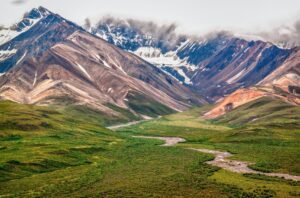Denali, a stunning landmark in the heart of Alaska, is a testament to nature’s might and majesty. With its height soaring to 6,190m or 20,310 feet, Denali is a remarkable and imposing feature in the Alaska Range and the crown jewel of the Denali National Park. Its name, translating to “The Great One” in the Athabascan language, reflects its grandeur and eminence. Climbing Denali is among the most challenging endeavours, and here’s why.
As the highest peak in North America and the third most prominent in the renowned Seven Summits, Denali’s prestige extends far beyond the borders of the United States. It is known for its prominence and is recognized as Earth’s third most isolated peak. Moreover, it is 210km northwest of Anchorage and 275km east of Fairbanks. Its location in the depths of the Alaskan wilderness further amplifies its allure to adventurers seeking remote and challenging terrains.
In terms of ascents, the first verifiable climb to the summit was accomplished in 1913 by a courageous group of four climbers via the South Summit. Later, in 1951, the West Buttress route was officially used for the first time. This way has become the most popular choice due to its relatively more straightforward trajectory.
However, Denali’s eternal shroud of ice and piercingly cold temperatures makes it formidable. Even in the warmth of midsummer, the weather station on the peak records temperatures as low as -59.26F (-50.7C) when factoring in wind chill. Thus, with its striking beauty, immense scale, and formidable conditions, Denali symbolizes the ultimate mountaineering achievement.
Mapping the Ascent: Navigating Denali’s Diverse Climbing Routes
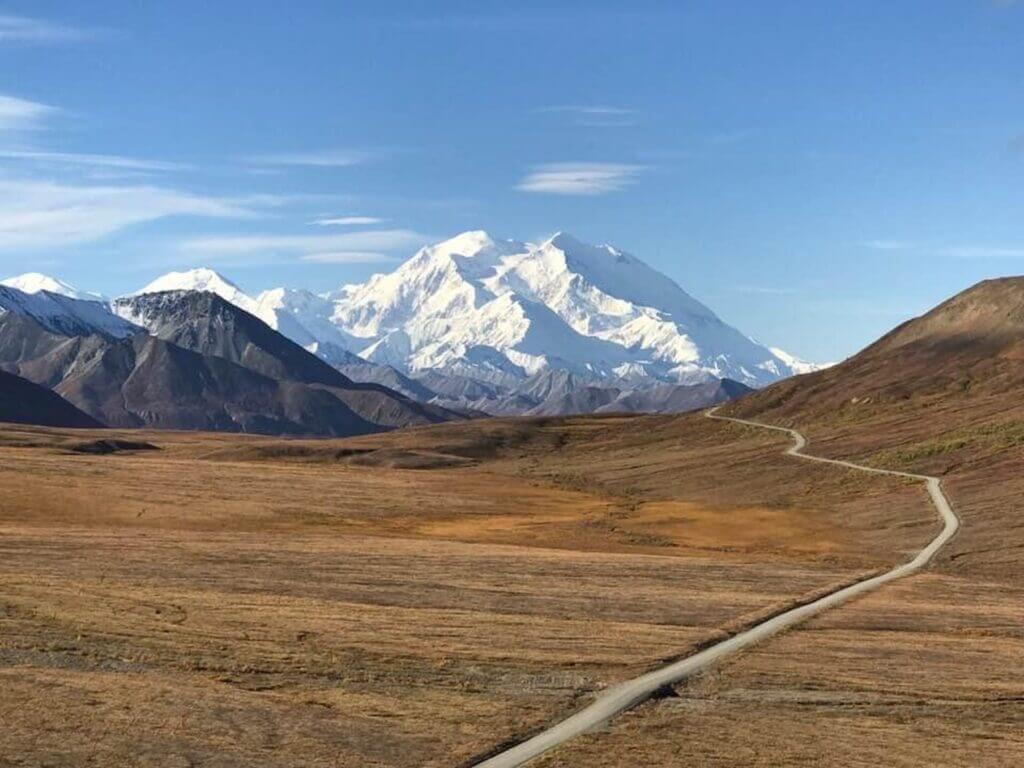
Choosing the optimal route is essential to the preparation for scaling Denali. The West Buttress route, attracting over 90% of climbers, is known for its comparatively lower technical demands. While still challenging, this path offers a balanced approach to reaching the summit, making it a favoured option for many adventurers.
The Muldrow Glacier route on Denali’s north side stands as an alternative. Although similar in length and difficulty to the West Buttress, this route requires a more significant commitment from climbers as it begins with a hike-in, contrary to the fly-in convenience available for the West Buttress. As such, the Muldrow Glacier route is often chosen by those yearning for a more engaging journey.
The remaining routes, including the West Rib and others, have markedly higher technical demands. Although taken by only a handful of climbers each year, the West Rib presents a more daunting challenge due to its increased technicality and risk. The other paths are even more complex and committing, suitable solely for those proficient in high-altitude mountaineering. Despite Denali not being the world’s highest peak, it does claim the largest elevation gain globally, a significant 5,500m. This fact underscores the importance of careful route selection for a successful and secure climb.
Climbing Denali: A Step-by-Step Journey Up the West Buttress Route
The West Buttress Route, the most popular path up Denali, begins at a basecamp perched at 2,194m on the southeast fork of Kahiltna Glacier. From this starting point, climbers descend Heartbreak Hill, transitioning onto the main section of the glacier, then begin the first significant elevation gain by ascending Ski Hill, reaching just below the Kahiltna Pass.
The route then shifts eastwards, leading climbers up a glacial valley to the foot of Motorcycle Hill. Here, climbers face the challenge of ascending Motorcycle Hill, a journey that rewards stunning views of the Fathers and Sons Wall and the Peters Glacier. This climb is followed by the ascent of Squirrel Hill, leading to the expansive space of the Polo Field, situated at the base of the West Buttress.
From the Polo Field, climbers circumnavigate Windy Corner and continue their ascent to the Genet Basin. Emerging from the northern side of the basin, they use fixed lines to climb to the ridge of the West Buttress. The summit push begins, taking climbers along the Autobahn to Denali Pass.
The journey continues along the ridge line, passing landmarks like the Zebra Rocks and the Archdeacon’s Tower. A challenging climb of six hundred vertical feet from the Football Field awaits, leading to the top of Pig Hill and the final summit ridge. After a last push along the spine, climbers reach the South Peak. A brief celebration ensues before they embark on the return journey, retracing their steps down the majestic slopes of Denali.
Muldrow Glacier Route: Climbing Denali & Completing Rugged Northern Challenge
The Muldrow Glacier route, nestled on the northern side of Denali, offers a distinct challenge compared to the classic West Buttress Route. Its defining feature is a formidable approach, as climbers must traverse nearly 140km from Wonder Lake to the glacier by foot in the summer or by skis in the winter. This demanding trek, a rigorous warm-up for the climb, starkly contrasts the fly-in convenience available to those embarking on the West Buttress Route.
Commencing at Wonder Lake, the standard route travels through the park, descends to the McKinley River, then follows the east fork of Clearwater Creek to Cache Creek, and finally to McGonagall Pass. This portion of the journey typically spans three days. The climbers then ascend the Muldrow Glacier along its northern side towards the Lower Icefall. Due to the dynamic nature of this active glacier, the pathways used for ascent and descent often diverge significantly.
From the base of the Great Icefall, climbers steer left towards Karstens Notch, passing alongside Mt Carpe and Mt Koven, then follow the ridge to a conspicuous step. The trail then proceeds towards the Coxcomb section and beyond to the Browne Tower. From there, climbers navigate northwards through Parker Pass and traverse two portions of icefall before aligning southeast towards Denali. Finally, the route merges with the standard West Buttress Route or shifts northeast towards the climb to the North Summit, offering climbers a challenging and immersive experience on their quest to conquer Denali.
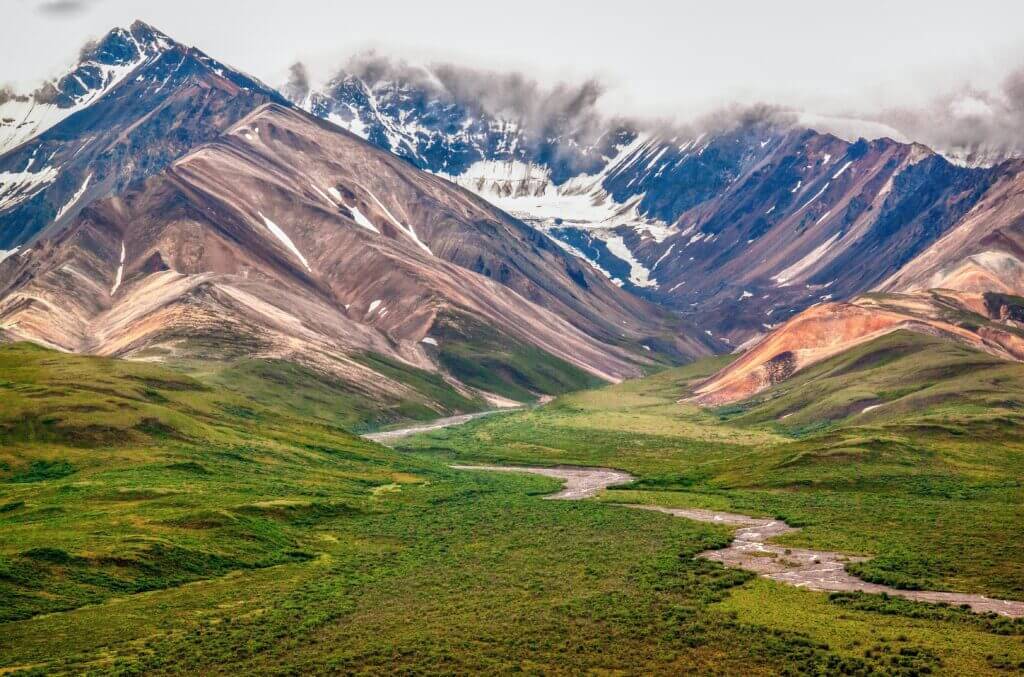
Denali’s West Rib: A Bold Ascent for the Fearless Climber
A formidable alternative to the standard West Buttress route, the West Rib presents a more technical climb, appealing to those who seek an additional layer of challenge in their Denali ascent. The Rib is a striking three-mile ridge that juts out from an impressive base at eleven-thousand feet.
The journey along this route unfurls various technical challenges designed to test even the most seasoned climbers. From traversing delicate crests to scaling steep faces of a daunting 55 degrees, the West Rib offers a thrilling adventure teetering on the edge of the extraordinary.
Its near-direct line from base to summit sets the West Rib apart. This audacious path presents an exhilarating challenge that bold climbers often find hard to resist. The daring simplicity of its course from the mountain’s foot to its peak underscores the West Rib’s appeal as a route that promises a significant accomplishment and an unforgettable high-altitude adventure.
Typical Itinerary For Climbing Denali
The allure of Denali beckons adventurers with the promise of a grand alpine journey along the famed West Buttress Route. A classic in the mountaineering world, this route demands a strategic approach. Climbers methodically leap-frog their supplies, ensuring a streamlined ascent while building robust camps at strategic intervals.
Denali‘s unpredictable weather mandates flexibility. With swiftly changing conditions, climbers might patiently wait for the skies to clear, ensuring a safer summit attempt. Fortunately, a 22-day expedition typically accommodates the climb and unforeseen weather delays. The blend of nature’s unpredictability and the thrill of climbing make this expedition a testament to nature’s majesty and human perseverance.
Denali’s Ascent: A 16-Days Climbing Chronicle
Day 1: Organise Climbing Equipment
In the shadow of Denali, the first day unfolds methodically under the guidance of your chosen guide company. It’s an essential day of preparation as climbers sort, check, and pack their equipment. Not just a day for gear, it’s also a valuable opportunity to review vital climbing skills and delve deep into crevasse rescue techniques. As the sun sets, climbers find respite in the cosy enclave of Talkeetna, gearing up mentally for the adventure ahead.
Day 2: Flight to Base Camp
Day two marks a pivotal moment. Following enlightening discussions with the crew and the conclusive gear weighing, climbers indulge in one last hearty meal in familiar territory. Then, the journey truly begins. The flight to the Base Camp, set at 7,200 feet, offers unparalleled vistas that promise the grandeur of what lies ahead. Upon landing, the day culminates with climbers nestling into their tents, resting up for the adventure that awaits with the dawn.
Day 3: Base Camp to Camp 1
As the sun rises on day three, climbers embark on a 5.5-mile journey. While the elevation gain is modest, the trek challenges the body and introduces climbers to the nuances of their gear. The distance allows ample time to familiarize oneself with the backpack’s fit and cultivate camaraderie within the group. The day culminates at Camp 1, situated at 7,800 feet, nestled in a compression zone near the foothills of Ski Hill.
Day 4: Provisions at Kahiltna Pass
The fourth day involves a focused mission: transporting provisions. The group ascends Ski Hill, trekking 5 miles to the base of Kahiltna Pass, standing tall at 9,700 feet. Here, vital supplies are cached, ensuring they’re readily available for the journey ahead. With the task accomplished and backpacks lightened, climbers return to Camp 1, invigorated and brimming with energy, anticipating the challenges to come.
Day 5: Transition to Camp 2
Day five presents a significant upward thrust, covering 4 miles from Camp 1 to reach the elevated stance of Camp 2 at 11,000 feet. The exhilarating challenge of a pronounced elevation gain marks the day’s trek. Upon arrival, climbers industriously construct a resilient encampment at the foothills of Motorcycle Hill, designed to brave Denali’s unpredictable storms.
Day 6: Resupply at Camp 2
The sixth day offers a contrasting pace. With the primary task of transporting gear from the previously stashed cache to Camp 2, climbers experience a semblance of rest amidst their taxing expedition. As the day concludes, the new fortress stands stocked and prepared for the subsequent stages of this awe-inspiring ascent.
Day 7: Securing Supplies at Windy Corner
The seventh day brings an endeavour of elevation as climbers haul half their equipment through the challenging terrains of Motorcycle Hill and Squirrel Hill. Ascending these hills, a plateau emerges post-Windy Corner, perched at an impressive 13,500 feet. Here, a strategic cache is buried, ensuring supplies are ready for subsequent legs of the climb. Amidst this preparation, climbers are rewarded with breathtaking panoramas: the sprawling expanse of Kahiltna Glacier and the formidable peaks encircling the ascent. As the day winds down, the team retraces their steps back to the haven of Camp 2.
Day 8: Ascent to Camp 3
The eighth day marks a significant milestone in the climb. Climbers are enveloped by the sensation of genuinely soaring high when they establish their base at Camp 3, positioned at a lofty 14,200 feet. At this altitude, they stand shoulder to shoulder with nature’s marvels, notably the peak of Mt. Hunter, its pinnacle resonating at the same towering height. This camp offers a vantage point for the journey ahead and a moment of reflection on the awe-striking beauty of the surroundings.
Day 9: Regrouping and Mastery at Camp 3
On the ninth day, the expedition sees climbers retrieving their equipment stashed at 13,500 feet, channelling their energy to transport it to Camp 3 safely. While demanding in its right, compared to other days on Denali’s slopes, it presents a gentler pace, offering climbers a brief yet valuable respite.
Day 10: Ascending the Challenging Slopes to 16,500 ft
The tenth day stands in stark contrast, tasking climbers with a demanding ascent to cache provisions at 16,500 feet. The journey begins over moderate slopes, but the true challenge emerges soon. A formidable 900-foot stretch, angled at a steep 45 degrees, comprises snow and ice. Armed with ascenders for self-belaying, climbers navigate this expanse, their efforts culminating upon the ridge of the West Buttress. It’s a testament to their grit and preparation, with nature unfurling its challenges and beauty.
Day 11: A Day of Repose at Camp 3
Amid the escalating journey, Day 11 offers climbers a much-needed breather. Nestled at Camp 3, adventurers find themselves at impressive altitudes, standing parallel to the majestic peak of Mt. Hunter. The day provides a moment to rejuvenate, relishing the serene beauty while preparing mentally and physically for the challenges ahead.
Day 12: The Journey to High Camp
The twelfth-day beckons with renewed vigour. The path ahead, laden with fixed lines, leads climbers to the crest. From there, a 600-foot ridge walk towards the imposing Washburn’s Tower awaits. The day’s efforts culminate at Camp 4, strategically positioned on a saddle above the Rescue Gully. As the pinnacle of their journey draws closer, climbers bed down at a staggering 17,200 feet, with the vast wilderness of Denali enveloping them.
Day 13: A Pause at Camp 4
At the imposing heights of Camp 4, climbers find themselves in a waiting game. With the erratic weather of Denali acting as the final gatekeeper to the summit, patience is the order of the day. Resting, recovering, and perhaps engaging in contemplative moments, teams typically spend at least one day here, with contingencies in place for possible extended waits to ensure optimal conditions for the pinnacle ascent.
Day 14: The Grand Ascent
The anticipation reaches its peak on the fourteenth day: Summit Day. Climbers embark on a challenging traverse across steep snowy terrains leading to Denali Pass. Their journey continues past the towering Archdeacon’s Tower and onto the expansive stretch named Football Field. With the goal in sight, the path winds up moderate terrains, culminating in the final 300-foot push to the zenith of North America. As climbers stand atop this magnificent peak, they take a moment to absorb their accomplishment’s grandeur before descending to High Camp for a well-deserved rest.
Days 15 & 16: Homeward Bound
With the summit chapter closed, climbers retrace their steps, dedicating two days for a careful descent back to Base Camp. Whether retracing their original path or navigating similar routes, the emphasis remains on safety and reflection. Once at Base Camp, the wings of a waiting flight whisk climbers away to Talkeetna, marking the end of their Denali adventure and a return to the comforts of their hotel.
Denali’s Prime Time: Choosing the Right Window for Ascent
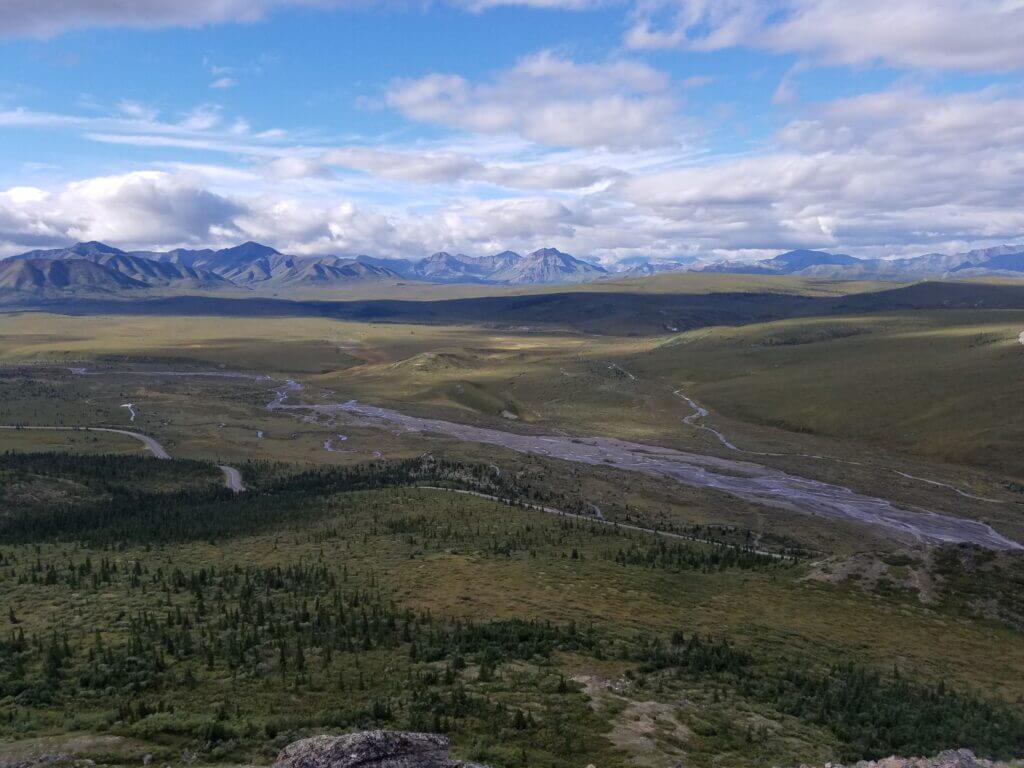
The allure of Denali beckons climbers from across the globe, and choosing the optimal time for the ascent is pivotal. The conventional climbing season spans from May to July, but it’s imperative to recognize the mountains’ capricious nature and not solely depend on general observations.
Denali’s Early Season
The early season before 7 May promises solitude, with colder temperatures prevailing across all elevations. The higher altitudes have less snow, but the snow is likely wind-packed. The sense of isolation is tangible, as there are fewer climbers. This offers a secluded experience but reduces the number of potential aids in emergencies. Climbers should be prepared to establish their camps. Depending on the year, the glacier at lower elevations may pose fewer crevasse hazards.
Denali’s Mid-Season
As the calendar progresses to mid-season from 7 May to 10 June, the lower regions of the mountain become warmer. With this warmth, higher elevations begin to receive snowfall, which can accumulate, potentially increasing avalanche hazards. This period witnesses a surge in climbers, making the mountain a hub of activity. Moving into pre-existing camps is convenient, but they may bear the brunt of prior occupants’ waste. Meanwhile, the glacier’s lower sections are typically stable.
Denali’s Late Season
The late season after Mid-June ushers in hot temperatures, with rain possibly on the lower terrains. However, a blanket of snow envelops the upper reaches, adding beauty and amplifying avalanche risks. While the number of climbers dwindles, several established campsites are available for selection. It’s crucial to exercise caution as the lower terrains can be treacherous.
In essence, no specific period during the hiking season stands out as the definitive best. The decision hinges on individual preferences and priorities. As adventurers chart their course up Denali, understanding these seasonal nuances can shape their journey’s trajectory.
Denali Ascent: Challenges and Essential Insights
Denali Climb: A Test of Strength and Resilience
Climbing Denali is an undertaking that challenges even the most seasoned mountaineers. The inherent difficulties of this ascent are multifaceted, starting with the physical demands of bearing heavy backpacks, pulling sledges, and setting up camps in the thin atmosphere of high altitudes. Unlike other 8,000m peaks, Denali stands unique in its requirement that climbers transport their gear and food, with no porters available for assistance. Such burdens can be eased with rigorous training; however, the likelihood of success diminishes without such preparation.
Although not notably technical, the West Buttress route presents challenges. Climbers are faced with fixed lines that require scrambling up to 800 ft of solid glacial ice. The terrain at certain points rises at angles steeper than 50 degrees, a challenge made even tougher by the weight of the gear. Additionally, the necessity of crampons intensifies the experience, exerting additional pressure on a climber’s calves.
Beyond the physical, Denali’s extreme weather conditions introduce another dimension of difficulty. Climbers must not only navigate the mountain’s physical challenges but also withstand the harsh elements, which can lead to significant discomfort. This, paired with the unpredictability of the mountain’s environment, means that Denali poses both a physical and a mental challenge, making it a true test of a climber’s resilience and endurance.
Acclimatization in Mountaineering
Understanding the nuances of altitude sickness is paramount for the brave souls drawn to the peaks. Acclimatization is essential to any high-altitude adventure, especially for a challenging climb like Denali. Recognizing this importance, climbing operators have diligently incorporated specific days within the expedition solely for acclimatization, ensuring that climbers can adapt to the rarified environment.
But while operators play their part, climbers can arm themselves with knowledge and practices to mitigate the risk. Familiarity with the symptoms of altitude sickness — unsettling nausea, persistent headaches, and lingering fatigue — can be a crucial first line of defence. Equally vital are practices like maintaining hydration and refraining from alcohol and drugs, including sleeping pills, during the ascent. Such precautions enhance comfort and can potentially ward off more severe complications.
However, even with the best precautions, the mountain’s unpredictable nature may still challenge some climbers. In such instances, open communication with the guide becomes invaluable. If any signs of discomfort or illness manifest, it’s imperative to consult with the guide promptly. They possess the expertise to assess the situation and advise on the best action, ensuring a safer and more enjoyable mountaineering experience.
Gear Check List for Climbing Denali
Given its challenging high-altitude and cold conditions, climbing Denali, North America’s tallest peak, necessitates meticulous gear preparation. The essentials for this ascent are on par with other demanding climbs in frosty environments.
A blend of rental and purchase is often the optimal approach to assembling one’s gear. While renting some bulky equipment can be an economical choice, avid mountaineers might find it prudent to invest in certain items, ensuring they have equipment tailored to their needs and preferences.
Moreover, it’s noteworthy that touring companies have distinct inclinations regarding equipment. This underscores the importance of consistent communication with a team adviser during the gear acquisition phase. An open line ensures climbers are adequately equipped, merging individual requirements with group-specific guidelines. This collaboration paves the way for a safer and more harmonized expedition.
Permits & Costs for Climbing Denali
Navigating the intricacies of permits and expenses is crucial for anyone planning an ascent of Denali. All climbers should mark their calendars and ensure they apply for the required permit at least 60 days before their expedition. It’s worth noting, however, that some touring packages may conveniently include this permit, alleviating the need for individual applications.
Travelling to the starting point is another factor to consider. For those jetting in from New York City, a flight to Anchorage typically hovers around the $700 mark.
Moreover, the choice of tour company significantly influences the overall expense. A reliable touring company dedicated to providing a memorable and safe ascent often sets prices around $9,000. While there is a spectrum of prices in the market, this ballpark figure is a guideline for what one might expect to invest for a quality Denali experience.
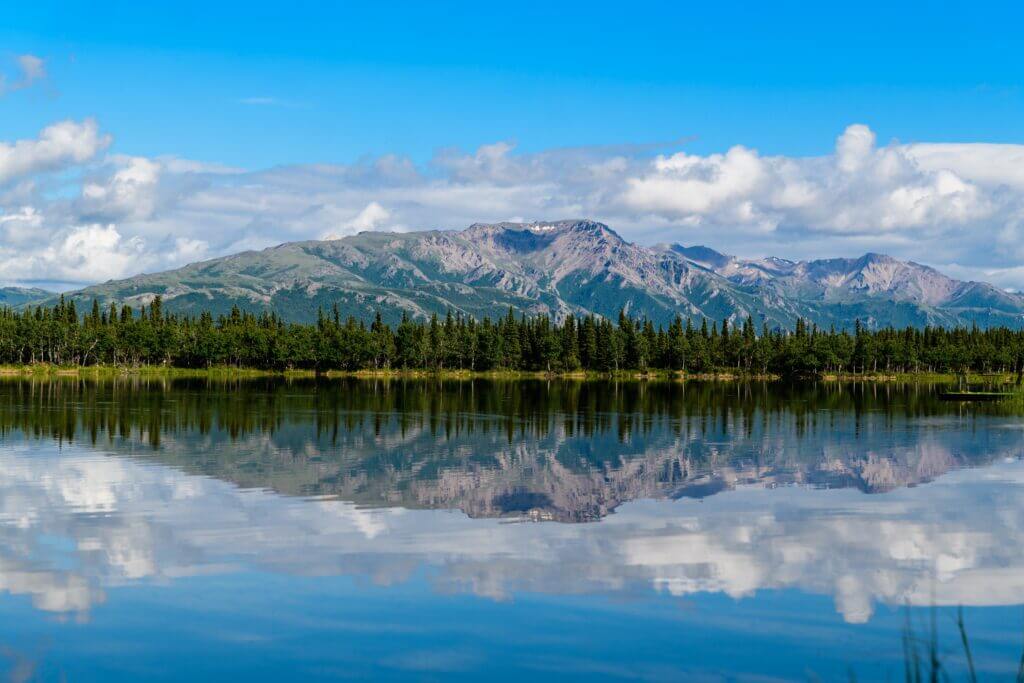
Training for Denali
Gearing Up for Denali
Denali’s ascent is monumental, with only half its challengers reaching the summit. To embark on this journey, a rigorous training regimen is non-negotiable. Mountaineers must showcase proficiency in skills, including crampons, snow walking, self-arrest, crevasse rescue, and glacier travel within a rope team. While some tour guides might require even deeper expertise, Prep Courses are available to refine these techniques for those lacking direct experience.
Practical climbing exposure further enriches a mountaineer’s readiness. Most successful Denali climbers have summited at least two other peaks prior to the main expedition. Ideal training terrains include Washington’s North Cascades, Rainier, and certain Alaskan spots.
European-trained climbers should note that North American terrains, notably different from the Alps, demand diverse expertise. It’s recommended that these mountaineers undertake at least one North American expedition before Denali. Consulting with your tour company will provide a tailored roadmap for optimal preparation.
Denali Training Objectives
The path to conquering Denali demands a rigorous blend of physical stamina and mental fortitude. Climbers are expected to traverse snowy inclines for extended periods, often up to 8 hours daily. This trek isn’t light-footed either; carrying an additional 50 lbs on their back and pulling a sledge weighing 35-40 lbs becomes the norm. Beyond sheer endurance, the capacity to rejuvenate after each day’s exertion, ready to embark anew, is paramount. Furthermore, the journey might sometimes call upon physical and mental reserves, especially during unforeseen challenges where survival becomes paramount.
Prospective Denali adventurer should kick-start their training with a robust baseline of fitness, ideally commencing at least six months before the expedition. Over these months, the intensity and frequency of the training gradually increase. The regimen encompasses aerobic activities, including running and cycling, strength exercises and endurance drills like cross-country skiing. As the departure nears, the training schedule becomes even more demanding: about five aerobic sessions weekly, predominantly centred on hill or stair climbing with backpacks weighing no less than 50 lbs, and four strength sessions focusing on endurance with high repetitions and lighter weights, prioritizing stamina over bulk.
Mental preparation, however, is a facet that often transcends structured training. Conversing with seasoned climbers, and absorbing their experiences and insights offers an invaluable perspective. Such exchanges foster a deeper understanding and readiness for the forthcoming challenges, ensuring climbers are physically and mentally attuned to the Denali ascent.

